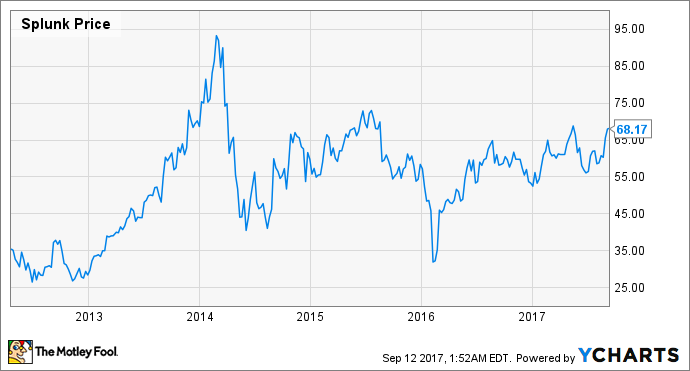It has been an up-and-down ride the last few years for owners of Splunk (SPLK), but the company had another solid quarter, reported Aug. 24, and the stock is back on the rise. And while 2017 has been good thus far for company, it may not be too late for investors to jump on board.
Data by YCharts.
The growing need for "big data" analysis
Splunk specializes in operational intelligence, allowing organizations to monitor and analyze data created by their machines in real time. Whether it's deployed for computers, payment processing terminals, websites, or other electronic equipment, Splunk's cloud-based platform helps organize massive amounts of information into a usable format.
For example, if your business operates a high-volume call center, knowing things like who is calling and where they live might be helpful. If you have many customers from a specific geographic region calling all at once, that could be especially helpful information to stay ahead of a potential snafu. Splunk can help a company recognize operational trends like that to get a leg up.
Though the stock has been a bumpy ride since an initial run-up in price post-IPO in 2012, revenues have been steadily growing and recently surpassed $1 billion in trailing-12-month sales. That has been supported by a fast-growing pool of customers that subscribe to Splunk's software. During the last quarter, over 500 new customers were added, bringing the total count to over 14,000.
Data by YCharts.
The "big data" company has big ambitions, and wants 20,000 total customers by 2020. If it hits that goal, it thinks it can also hit $2 billion in annual revenues. That's ambitious, but Splunk is taking great strides to make it happen. With that kind of growth, the company is surely a buy, right?

Image source: Getty Images.
Valuing an unprofitable company
To investors who just look at the bottom line, what jumps out immediately about Splunk is that there are no profits. While that may present a problem for some, there's more to the story here before writing Splunk off.
First off, the company offers up an adjusted bottom line that excludes the impact of non-operating items like stock-based compensation to employees and the amortization of intangible assets. By that non-GAAP measure, Splunk turned an $0.08 per share profit last quarter, up 60% from the $0.05 reported the same time in 2016. In the last four months, total adjusted earnings per share is at $0.44.
With those adjustments, Splunk's adjusted price-to-earnings (P/E) ratio is still at 155, and while paying for 150 years' worth of current profits is rich by anyone's valuation, the picture gets better if we use free cash flow. Put simply, that's the money left after basic operations are paid for.
Data by YCharts.
Splunk has been steadily increasing its free cash flow for years. As a result, the company continues to get cheaper when measured by its price-to-free cash flow ratio, which currently sits at 54.
That's still a steep price to pay, though. So why would an investor consider Splunk? It's all about the future. As previously mentioned, the company has a lofty target of doubling revenues to $2 billion in the next few years. In the first six months of 2017, $522 million has been reported.
By year's end, though, management thinks annual revenue will slightly exceed $1.2 billion. That's a 26% increase over $950 million last year, and if that pace continues, the company will hit $2 billion by its goal of 2020. When using total billings, which adds in money that customers have committed to spend but haven't paid yet, Splunk says the figure will be $1.45 billion this year. That's a good indication that sales will continue to track higher.
Big data is only getting bigger
For Splunk stock, it's all about the runway for sales growth. Investors have to believe in where the company is going and how it's going to get there. Higher share prices can be justified now as long as management can keep delivering double-digit revenue growth. If it misses the mark, though, the roller-coaster ride that has been the last few years will resume.
However, with the number of devices in the world growing, and therefore growing the amount of data in need of analysis, demand for Splunk's service looks like it will continue to increase. For those willing to stomach some uncertainty, this stock could be a reasonable pickup right now.








